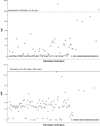Seroprevalence of histoplasmosis in Kampala, Uganda
- PMID: 26527637
- PMCID: PMC4837699
- DOI: 10.1093/mmy/myv081
Seroprevalence of histoplasmosis in Kampala, Uganda
Abstract
Histoplasmosis is endemic to the Midwestern United States, but cases have been reported nearly worldwide. A 1970 study found 3.8% skin test sensitivity to Histoplasma capsulatum in Uganda but no systemic study of histoplasmosis exposure has occurred since the onset of the human immunodeficiency virus (HIV) pandemic. This study investigated the seroprevalence of H. capsulatum and sought previously undetected cases of histoplasmosis in Kampala, Uganda. Serum, cerebrospinal fluid (CSF) and/or urine specimens were obtained from HIV-infected persons with suspected meningitis. Specimens were tested for H. capsulatum IgG and IgM by enzyme immune assay and Histoplasma antigen. 147 of the 257 subjects who were enrolled had cryptococcal meningitis. Overall, 1.3% (2/151) of subjects were serum Histoplasma IgG positive, and zero of 151 were IgM positive. Antigen was not detected in any serum (n = 57), urine (n = 37, or CSF (n = 63) samples. Both subjects with serum Histoplasma IgG positivity had cryptococcal meningitis. Histoplasma capsulatum IgG was detected at low levels in persons with HIV/AIDS in Kampala, Uganda. Histoplasmosis is not widespread in Uganda but microfoci do exist. There appears to be no cross-reactivity between Cryptococcus neoformans and Histoplasma antigen testing, and cryptococcosis appears to be at most, a rare cause of positive Histoplasma IgG.
Keywords: Diagnostic Techniques and Procedures; Histoplasmosis; Histoplasmosis capsulatum; Human Immunodeficiency Virus; Validation Studies; seroepidemiologic studies.
© The Author 2015. Published by Oxford University Press on behalf of The International Society for Human and Animal Mycology. All rights reserved. For permissions, please e-mail: journals.permissions@oup.com.
Figures

References
-
- Cottle LE, Gkrania-Klotsas E, Williams HJ, et al. A multinational outbreak of histoplasmosis following a biology field trip in the Ugandan rainforest. J Travel Med. 2013;20:83–87. - PubMed
-
- Bezjak V, Farsey SJ. Prevalence of skin sensitivity to histoplasmin and coccidioidin in varous Ugandan populations. Am J Trop Med Hyg. 1970;19:664–669. - PubMed
-
- Wheat LJ, Freifeld AG, Kleiman MB, et al. Clinical practice guidelines for the management of patients with histoplasmosis: 2007 update by the Infectious Diseases Society of America. Clin Infect Dis. 2007;45:807–825. - PubMed
Publication types
MeSH terms
Substances
Grants and funding
LinkOut - more resources
Full Text Sources
Other Literature Sources
Medical

